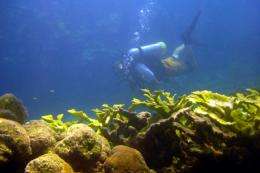New mathematical model helps biologists understand how coral dies in warming waters

(PhysOrg.com) -- Cornell University researchers have found a new tool to help marine biologists better grasp the processes under the sea: They have created mathematical models to unveil the bacterial community dynamics behind afflictions that bleach and kill coral.
Warming waters are triggering coral bleaching and disease in the Caribbean, Indian Ocean and Great Barrier Reef off the Australian coast. Now new mathematical models explain for the first time how beneficial bacteria on coral suddenly give way to pathogens when waters warm.
"Before this study, we just had observations but little understanding of the mechanism" for what causes coral disease and bleaching, said Laura Jones, Cornell senior research associate in ecology and evolutionary biology. Justin Mao-Jones '08, conducted the research as an undergraduate in the School of Operations Research and Information Engineering, is the paper's lead author.
The model reveals how a healthy normal microbial community in the coral surface mucus layer protects corals from disease by preventing invasion and overgrowth by pathogenic bacteria. But when corals are stressed, for example by elevated temperatures (a heat spell), the community of microbes suddenly switches. Species associated with a healthy coral organism - "resident species" - decline as pathogens associated with coral disease take their place.
The researchers used models to simulate bacterial community dynamics within the surface coral mucus, under normal conditions, and under the warming conditions that lead to a sudden shift from beneficial bacteria to pathogens on the coral's surface.
"There's a critical threshold where the system jumps to a pathogen-dominated state," said Jones.
They also found that the models replicated a pattern others have observed: once the disease-causing microbes establish themselves, they persist even if the water cools down enough to favor the beneficial bacteria. The coral is then often too damaged to recover, and the reefs begin to die.
Preventing oceans from warming will require people to curb climate change, and may be unavoidable in the short term, said Jones. But reducing poor water quality, which stresses the coral and makes the oceans more hospitable to pathogens, could perhaps ward off the sudden shift to pathogens dominating the coral surface, she added.
More information: Public Library of Science - Biology, March 30, 2010.
Provided by Cornell University

















